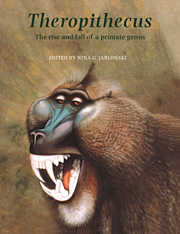Book contents
- Frontmatter
- Contents
- List of Contributors
- Preface
- Acknowledgements
- 1 Introduction
- PART I Fossil evidence and phylogeny
- PART II Biogeography and evolutionary biology
- PART III Anatomy of the fossil and living species of Theropithecus
- 10 Allometric aspects of skull morphology in Theropithecus
- 11 Evolution of the masticatory apparatus in Theropithecus
- 12 Dental microwear and diet in extant and extinct Theropithecus: preliminary analyses
- 13 The development and microstructure of the dentition of Theropithecus
- 14 Postcranial anatomy of extant and extinct species of Theropithecus
- PART IV Behaviour and ecology of living and fossil species of Theropithecus
- Appendix I A partial catalogue of fossil remains of Theropithecus
- Appendix II Conservation status of the gelada
- Index
13 - The development and microstructure of the dentition of Theropithecus
Published online by Cambridge University Press: 11 November 2009
- Frontmatter
- Contents
- List of Contributors
- Preface
- Acknowledgements
- 1 Introduction
- PART I Fossil evidence and phylogeny
- PART II Biogeography and evolutionary biology
- PART III Anatomy of the fossil and living species of Theropithecus
- 10 Allometric aspects of skull morphology in Theropithecus
- 11 Evolution of the masticatory apparatus in Theropithecus
- 12 Dental microwear and diet in extant and extinct Theropithecus: preliminary analyses
- 13 The development and microstructure of the dentition of Theropithecus
- 14 Postcranial anatomy of extant and extinct species of Theropithecus
- PART IV Behaviour and ecology of living and fossil species of Theropithecus
- Appendix I A partial catalogue of fossil remains of Theropithecus
- Appendix II Conservation status of the gelada
- Index
Summary
Summary
Radiographs were made of 11 specimens of Theropithecus gelada of unknown chronological age ranging from newborn to young adult. Tooth buds were removed from the younger specimens and stained with alizarin red S. The tooth buds were then studied using a dissecting microscope. In addition, teeth were removed from four juvenile mandibles and embedded in polyester using a prolonged impregnation and curing schedule. These teeth were then studied employing various histological techniques.
At birth, the deciduous teeth of T. gelada were similar in development to those of Papio hamadryas cynocephalus, Macaca mulatta, M. nemestrina and Alouatta caraya. The first permanent molars were also calcified at birth in all species examined and were always more mature in the monkey species than in Pan troglodytes and Homo sapiens.
The sequence of permanent tooth eruption in T. gelada was M1, I1, I2, M2, [P3, P4, G], M3, a pattern not unlike that reported for other cercopithecid monkeys as well as for the fossils, T. brumpti and T. oswaldi. The estimated age (in years) of eruption of the permanent teeth using histological data was: M1 = 1.7; I1, 12 = 3.0–3.2; M2 = 3.5–4.0; P3, P4, G = 4.2–5.3; M3 = 6.0–6.5.
It was suggested that the distal accessory cuspules on M1−2 in T. gelada are serially homologous with the M3 hypoconulid and that they represent an adaptation for maintaining mesiodistal contact between adjacent molars thereby limiting early interstitial attrition. Likewise, the hyposodont molars and late eruption of M3 appear to be dental adaptations to prolong or delay tooth loss.
[…]
- Type
- Chapter
- Information
- TheropithecusThe Rise and Fall of a Primate Genus, pp. 351 - 382Publisher: Cambridge University PressPrint publication year: 1993
- 14
- Cited by



